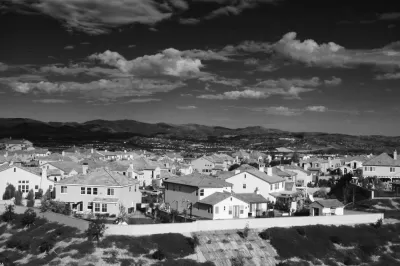What motivates sprawl? It's more than just automobile infrastructure.

I have a mental conception of what sprawl looks like: mostly air with vinyl exoskeleton and asphalt driveways—the ubiquitous 'burbs. Professor Michael Lewyn listed some of its agents in his recent piece for Planetizen, "How to Teach About Sprawl (and Law)." He primarily focuses on the usual spatial suspects: wide (too wide) streets and lots for (too) big houses. In this picture sprawl is largely associated with the 'burbs and big box stores, an "inefficient" use of land. Here I'll go into what enables the spatial actants.
In his book, All Over the Map, architect Michael Sorkin critically explores some of the agents that give cities their form. He asks us to look beyond the architecture of cities and inquire into the complex histories of them. In his essay exploring the physical and figurative Manhattan crater of 9/11 he writes, "The suburbs were fertilized by massive government intervention in highway construction, by radical tax policy, by changes in the national culture of desire, by racism, by cheap, unencumbered land, and by an earlier fear of terror."
Sprawl isn't simply design standards that require wasting land—for example, driving lanes that are substantially wider than vehicles, surface parking lot built to meet Christmas shopping peak demand, or McMansions that waste land (as much as they do air)—but something more holistic and nuanced. Sprawl is a socio-political-economic web complexly intertwined and interconnected, often messily and incomprehensibly but sometimes parsed by the bright ones scraping away the surface for deeper explorations.
As Sorkin writes, the fear of a terror attack induced policies for de-densification. Where we lived and worked needed to be designed to make for quick evacuations. The prospect of nuclear annihilation made urban concentrations particularly vulnerable. As GlobalSecurity.org reveals,
When President Eisenhower went to Kansas to announce the interstate highway system, he announced it as “the National Defense Highway System.” In 1956 [he] signed legislation establishing the National System of Interstate and Defense Highways (about 41,000 miles of roads). Since then, [Department of Defense] has continued to identify and update defense-important highway routes. The National Defense Highway system was designed to move military equipment and personnel efficiently.
Of course, The National Defense Highway ensured transportation routes was good for the automobile industry too. The massive de-urbanization in Maoist China was also the direct result of nuclear anxiety, Sorkin reminds us.
The typical dialectic of city versus suburb, however, is operationally meaningless when we explore a finer resolution for sprawl's agents: Our personal desire for a chunk of land, and the dominant mode of transportation that takes us from property chunk to property chunk; technologies that problematize the need to be a pedestrian to access businesses (the market-place ballet has been scrubbed by clicking and purchasing via intertubes).
There's also the financial system's need to sprawl. Capital ultimately gets laid down in bricks and mortar. Capital is any asset that generates a financial return. Real estate is physical capital, a place where money becomes something physical to earn a rate of return. Financially diagnosed cheap farm land, aided by government incentives, makes for a good return on investment. (The housing market in London or Vancouver isn't much interested in supplying a housing stock for its population, but that's another story.)
What we build is not detached from nature; it's getting laid down in the geological strata, which is amazingly disturbing. But I'll look at the Anthropocene epoch, and problematize it, in a future post. In brief, yes, sprawl is bad, and we need to explore and ultimately resist its agents. We live in an ecological system where we can't fully know how much damage we can do to it before it collapses. When we starting thinking about the complex mosaic of sprawl we begin to see its puppeteers. Don't be a puppet.
Connect with Steven on Twitter @stevenpsnell or Facebook stevenpsnell. Download his novel, Clear Running Water, at Smashwords.

Manufactured Crisis: Losing the Nation’s Largest Source of Unsubsidized Affordable Housing
Manufactured housing communities have long been an affordable housing option for millions of people living in the U.S., but that affordability is disappearing rapidly. How did we get here?

Americans May Be Stuck — But Why?
Americans are moving a lot less than they once did, and that is a problem. While Yoni Applebaum, in his highly-publicized article Stuck, gets the reasons badly wrong, it's still important to ask: why are we moving so much less than before?

Using Old Oil and Gas Wells for Green Energy Storage
Penn State researchers have found that repurposing abandoned oil and gas wells for geothermal-assisted compressed-air energy storage can boost efficiency, reduce environmental risks, and support clean energy and job transitions.

Updating LA’s Tree Rules Could Bring More Shade to Underserved Neighborhoods
A new USC study finds that relaxing Los Angeles’ outdated tree planting guidelines could significantly expand urban tree canopy and reduce shade disparities in lower-income neighborhoods, though infrastructure investments are also needed.

California's Canal Solar Projects Aim to Conserve Resources and Expand Clean Energy
California’s Project Nexus has begun generating electricity from solar panels installed over irrigation canals, with researchers and state agencies exploring statewide expansion to conserve water and boost clean energy production.

HHS Staff Cuts Gut Energy Assistance Program
The full staff of a federal program that distributes heating and cooling assistance for low-income families was laid off, jeopardizing the program’s operations.
Urban Design for Planners 1: Software Tools
This six-course series explores essential urban design concepts using open source software and equips planners with the tools they need to participate fully in the urban design process.
Planning for Universal Design
Learn the tools for implementing Universal Design in planning regulations.
Heyer Gruel & Associates PA
City of Moreno Valley
Institute for Housing and Urban Development Studies (IHS)
City of Grandview
Harvard GSD Executive Education
Salt Lake City
NYU Wagner Graduate School of Public Service
City of Cambridge, Maryland




























